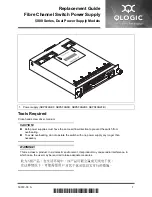
v
Managing disk arrays
Refer to this topic to see the interface for performing various tasks with disk arrays.
v
Creating a disk array
Use this procedure to start device parity protection.
v
Using hot spare disks
Hot spare disks are used to automatically replace a disk that has failed in a RAID environment.
v
Disk unit management
This procedure allows viewing disk status and disk unit details.
Viewing IBM SAS disk information
This procedure enables you to view SAS disk information, status, and details.
To view the SAS disk information and status, see the following:
v
v
IBM i Dedicated Service Tools (DST) options
Note:
The disk unit information options can also be accessed through System Service Tools. The
system does not need to be in dedicated service mode to display disk information. Some disk
configuration functions do require dedicated service mode.
v
v
Note:
This display shows disk unit details such as type, model, serial number, operating status,
capacity, and protection status.
Considerations for solid-state drives
Use this information to understand the importance of controller functions when you use solid-state drives
(SSD).
Hard-disk drives (HDD) use a spinning magnetic platter to store nonvolatile data in magnetic fields.
SSDs are a storage device using nonvolatile solid-state memory, typically flash memory, to emulate
HDDs. HDDs have an inherent latency and access time caused by mechanical delays in the spinning of
the platter and movement of the read/write head. SSDs greatly reduce the latency and time to access the
stored data. The nature of solid-state memory is such that read operations can be performed faster than
write operations and write cycles are limited. Using techniques, such as wear leveling and
overprovisioning, enterprise class SSDs are designed to withstand many years of continuous use.
SSD and HDD use
Follow these guidelines when using SSDs and HHDs.
v
Do not mix SSDs and HDDs within the same disk array. A disk array must only contain SSDs or
HDDs.
v
Do not mix SSDs and HDDs with system mirroring in the same mirrored pair. A mirrored pair must
only contain SSDs or HDDs.
v
It is important to plan for hot-spare devices when you use arrays of SSDs. An SSD hot-spare device
replaces a failed device in an SSD disk array. An HDD hot-spare device replaces a failed device for an
HDD disk array.
v
It is preferred that SSDs be protected by RAID 5, RAID 6, or by system mirroring.
v
See Installing and configuring Solid-state drives to identify specific configuration and placement
requirements related to the SSD devices.
SAS RAID controllers for IBM i
21
Summary of Contents for SAS RAID controllers
Page 1: ...Power Systems SAS RAID controllers for IBM i ...
Page 2: ......
Page 3: ...Power Systems SAS RAID controllers for IBM i ...
Page 6: ...iv SAS RAID controllers for IBM i ...
Page 70: ...58 SAS RAID controllers for IBM i ...
Page 80: ...68 SAS RAID controllers for IBM i ...
Page 81: ......
Page 82: ... Printed in USA ...
















































